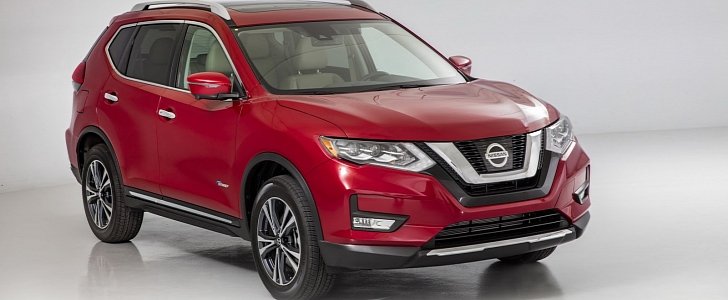Facelifted for the 2017 model year, the Nissan Rogue is also available as a hybrid. The Rouge Hybrid’s biggest selling point, of course, is gas mileage: 35 mpg highway.
The figure applies to the front-wheel-drive model. In the city, the Environmental Protection Agency rated the first-ever Rogue Hybrid 33 miles per gallon. “But I live in the Snowbelt, so I need all-wheel-drive!” Nissan hasn’t forgot about you folks, hence the Rogue Hybrid AWD.
With all four wheels driven, fuel economy drops to 34 miles per gallon on the highway and 31 mpg city. 33 combined isn’t too bad either, especially when you remember that the Rogue is classified as a compact crossover.
As for pricing, the Rogue SV FWD Hybrid starts from $26,240, making it $1,000 more expensive than the Rogue SV FWD. The range-topping Rogue SL AWD Hybrid, meanwhile, retails from $32,510 without accounting the $940 worth of destination and handling.
Compared to the ICE-only model, which employs a 2.5-liter inline-4, the Rogue Hybrid makes use of a 2.0-liter engine, a lithium-ion battery, and an electric motor with two-clutch control. The powerplant churns out 141 hp and 144 lb-ft, whereas the 30 kW electric motor has 40 hp and 118 lb-ft to offer. Net system output is 176 horsepower.
To set the Rouge Hybrid apart from the regular Rogue, Nissan applied Pure Drive HEV badging to the exterior. Another visual difference over the standard model is represented by the second row of seats, which comes only in 60/40 split folding form. The HEV gauge is also exclusive to the Rogue Hybrid.
Under the skin, the 2017 Nissan Rogue Hybrid hides something you’ll hear about often from here on in. More specifically, the dual horn includes a tidbit christened “Vehicle Sound Generator.” Under FMVSS No. 141, hybrids, plug-in hybrids, and electric vehicles that weigh less than 10,000 pounds need to have one. The Vehicle Sound Generator produces an audible noise when the car is powered by electricity - when reversing and at forward speeds of up to 19 mph (30 km/h) - to alert pedestrians that they're not alone.
With all four wheels driven, fuel economy drops to 34 miles per gallon on the highway and 31 mpg city. 33 combined isn’t too bad either, especially when you remember that the Rogue is classified as a compact crossover.
As for pricing, the Rogue SV FWD Hybrid starts from $26,240, making it $1,000 more expensive than the Rogue SV FWD. The range-topping Rogue SL AWD Hybrid, meanwhile, retails from $32,510 without accounting the $940 worth of destination and handling.
Compared to the ICE-only model, which employs a 2.5-liter inline-4, the Rogue Hybrid makes use of a 2.0-liter engine, a lithium-ion battery, and an electric motor with two-clutch control. The powerplant churns out 141 hp and 144 lb-ft, whereas the 30 kW electric motor has 40 hp and 118 lb-ft to offer. Net system output is 176 horsepower.
To set the Rouge Hybrid apart from the regular Rogue, Nissan applied Pure Drive HEV badging to the exterior. Another visual difference over the standard model is represented by the second row of seats, which comes only in 60/40 split folding form. The HEV gauge is also exclusive to the Rogue Hybrid.
Under the skin, the 2017 Nissan Rogue Hybrid hides something you’ll hear about often from here on in. More specifically, the dual horn includes a tidbit christened “Vehicle Sound Generator.” Under FMVSS No. 141, hybrids, plug-in hybrids, and electric vehicles that weigh less than 10,000 pounds need to have one. The Vehicle Sound Generator produces an audible noise when the car is powered by electricity - when reversing and at forward speeds of up to 19 mph (30 km/h) - to alert pedestrians that they're not alone.









